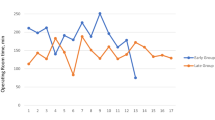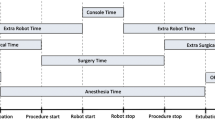Abstract
Background
Laparoscopic repair of a large hiatal hernia is technically challenging. A significant learning curve likely exists that has not been studied to date.
Methods
Since 1992, the authors have prospectively collected data for all patients undergoing laparoscopic repair of a very large hiatal hernia (50% or more of the stomach within the chest). Follow-up evaluation was performed after 3 months, then yearly. Visual analog scores were used to assess heartburn and dysphagia. Patients were grouped according to institutional and individual surgeons’ experience to determine the impact of any learning curve. The outcome for procedures performed by consultant surgeons was compared with that for trainees.
Results
From 1992 to 2008, 415 patients with a 1-year minimum follow-up period were studied. Institutional and individual experience had a significant influence on operation time, conversion to open surgery, and length of hospital stay. However, except for heartburn scores during a 3-month follow-up evaluation of institutional experience (p = 0.03), clinical outcomes were not influenced by either an institutional or individual learning curve. Furthermore, in general terms, whether the procedure was performed by a consultant or a supervised trainee had little effect on outcome.
Conclusions
Institutional and individual learning curves had no significant influence on clinical outcomes, although improved experience was reflected in improved operation time, conversion rate, and hospital stay. These outcomes improved over the first 50 institutional cases, and the outcomes for individual surgeons improved for up to 40 cases.


Similar content being viewed by others
References
Draaisma WA, Gooszen HG, Tournoij E, Broeders IA (2005) Controversies in paraesophageal hernia repair: a review of literature. Surg Endosc 19:1300–1308
Watson DI, Davies N, Devitt PG, Jamieson GG (1999) Importance of dissection of the hernial sac in laparoscopic surgery for large hiatal hernias. Arch Surg 134:1069–1073
Aly A, Munt J, Jamieson GG, Ludemann R, Devitt PG, Watson DI (2005) Laparoscopic repair of large hiatal hernias. Br J Surg 92:648–653
Mattar SG, Bowers SP, Galloway KD, Hunter JG, Smith CD (2002) Long-term outcome of laparoscopic repair of paraesophageal hernia. Surg Endosc 16:745–749
Watson DI, Baigrie RJ, Jamieson GG (1996) A learning curve for laparoscopic fundoplication: definable, avoidable, or a waste of time? Ann Surg 224:198–203
Hwang H, Turner L, Blair NP (2005) Examining the learning curve of laparoscopic fundoplication at an urban community hospital. Am J Surg 189:522–526
Voitk A, Joffe J, Alvarez C, Rosenthal G (1999) Factors contributing to laparoscopic failure during the learning curve for laparoscopic Nissen fundoplication in a community hospital. J Laparoendosc Adv Surg Tech 9:243–248
Carlson MA, Frantzides CT (2001) Complications and results of primary minimally invasive antireflux procedures: a review of 10,735 reported cases. J Am Coll Surg 193:521–523
Tekkis PP, Senagore AJ, Delaney CP, Fazio VW (2005) Evaluation of the learning curve in laparoscopic colorectal surgery: comparison of right-sided and left-sided resections. Ann Surg 242:83–91
Schlachta CM, Mamazza J, Seshadri PA, Cadeddu M, Gregoire R, Poulin EC (2001) Defining a learning curve for laparoscopic colorectal resections. Dis Colon Rectum 44:217–222
Ahlberg G, Kruuna O, Leijonmarck C, Ovaska J, Rosseland A, Sandbu R, Strömberg C, Arvidsson D (2005) Is the learning curve for laparoscopic fundoplication determined by the teacher or the pupil? Am J Surg 189:184–189
Zacharoulis D, O’Boyle CJ, Sedman PC, Brough WA, Royston CMS (2006) Laparoscopic fundoplication: a 10-year learning curve. Surg Endosc 20:1662–1670
Wijnhoven BPL, Watson DI (2008) Laparoscopic repair of a giant hiatus hernia: how I do it. J Gastrointest Surg 12:1459–1464
Shukri MJ, Watson DI, Lally CJ, Devitt PG, Jamieson GG (2008) Laparoscopic anterior 90° fundoplication for reflux or large hiatus hernia. ANZ J Surg 78:123–127
Jamieson GG, Watson DI, Britten-Jones R, Mitchell PC, Anvari M (1994) Laparoscopic Nissen fundoplication. Ann Surg 220:137–145
Ludemann R, Watson DI, Jamieson GG, Game PA, Devitt PG (2005) Five-year follow-up of a randomized clinical trial of laparoscopic total versus anterior 180° fundoplication. Br J Surg 92:240–243
Baigrie RJ, Cullis SNR, Ndhluni AJ, Cariem A (2005) Randomized double-blind trial of laparoscopic Nissen fundoplication versus anterior partial fundoplication. Br J Surg 92:819–823
Watson DI, Jamieson GG, Lally C, Archer S, Bessell JR, Booth M, Cade R, Cullingford G, Devitt PG, Fletcher DR, Hurley J, Kiroff G, Martin CJ, Martin IJ, Nathanson LK, Windsor JA (2004) Multicenter, prospective, double-blind, randomized trial of laparoscopic Nissen versus anterior 90 degrees fundoplication. Arch Surg 139:1160–1167
Schauer PR, Meyers WC, Eubanks S, Norem RF, Franklin M, Pappas TN (1996) Mechanisms of gastric and esophageal perforations during laparoscopic Nissen fundoplication. Ann Surg 223:43–52
Lowham AS, Filipi CJ, Hinder RA, Swanstrom LL, Stalter K, dePaula A, Hunter JG, Buglewicz TG, Haake K (1996) Mechanisms and avoidance of esophageal perforation by anesthesia personnel during laparoscopic foregut surgery. Surg Endosc 10:979–982
Kim J, Edwards E, Bowne W, Castro A, Moon V, Gadangi P, Ferzli G (2007) Medial-to-lateral laparoscopic colon resection: a view beyond the learning curve. Surg Endosc 21:1503–1507
Jin SH, Kim DY, Kim H, Jeong IH, Kim MW, Cho YK, Han SU (2007) Multidimensional learning curve in laparoscopy-assisted gastrectomy for early gastric cancer. Surg Endosc 21:28–33
Acknowledgments
The authors thank all participating surgeons for contributing to the database and Prof. A. Esterman, PhD, for support with the statistical analysis.
Disclosures
Eu Ling Neo, Urs Zingg, Peter G. Devitt, Glyn G. Jamieson, and David I. Watson have no conflicts of interest or financial ties to disclose.
Author information
Authors and Affiliations
Corresponding author
Additional information
E. L. Neo and U. Zingg contributed equally.
Rights and permissions
About this article
Cite this article
Neo, E.L., Zingg, U., Devitt, P.G. et al. Learning curve for laparoscopic repair of very large hiatal hernia. Surg Endosc 25, 1775–1782 (2011). https://doi.org/10.1007/s00464-010-1461-8
Received:
Accepted:
Published:
Issue Date:
DOI: https://doi.org/10.1007/s00464-010-1461-8




